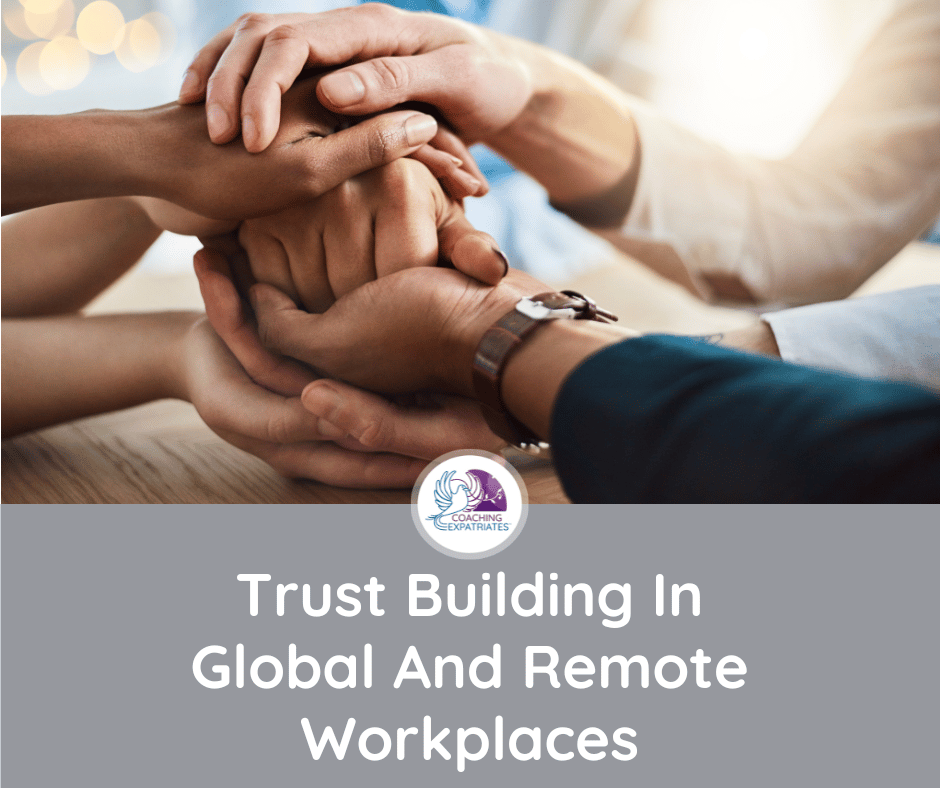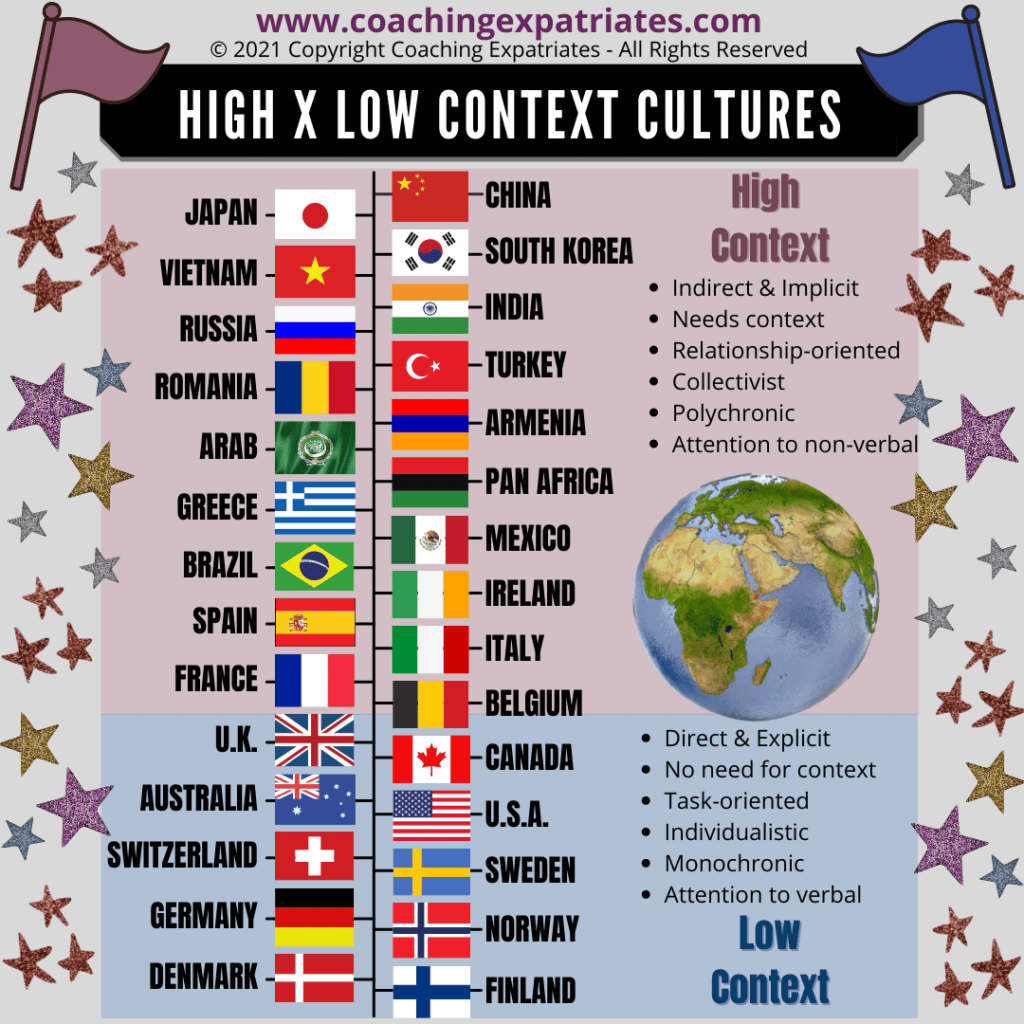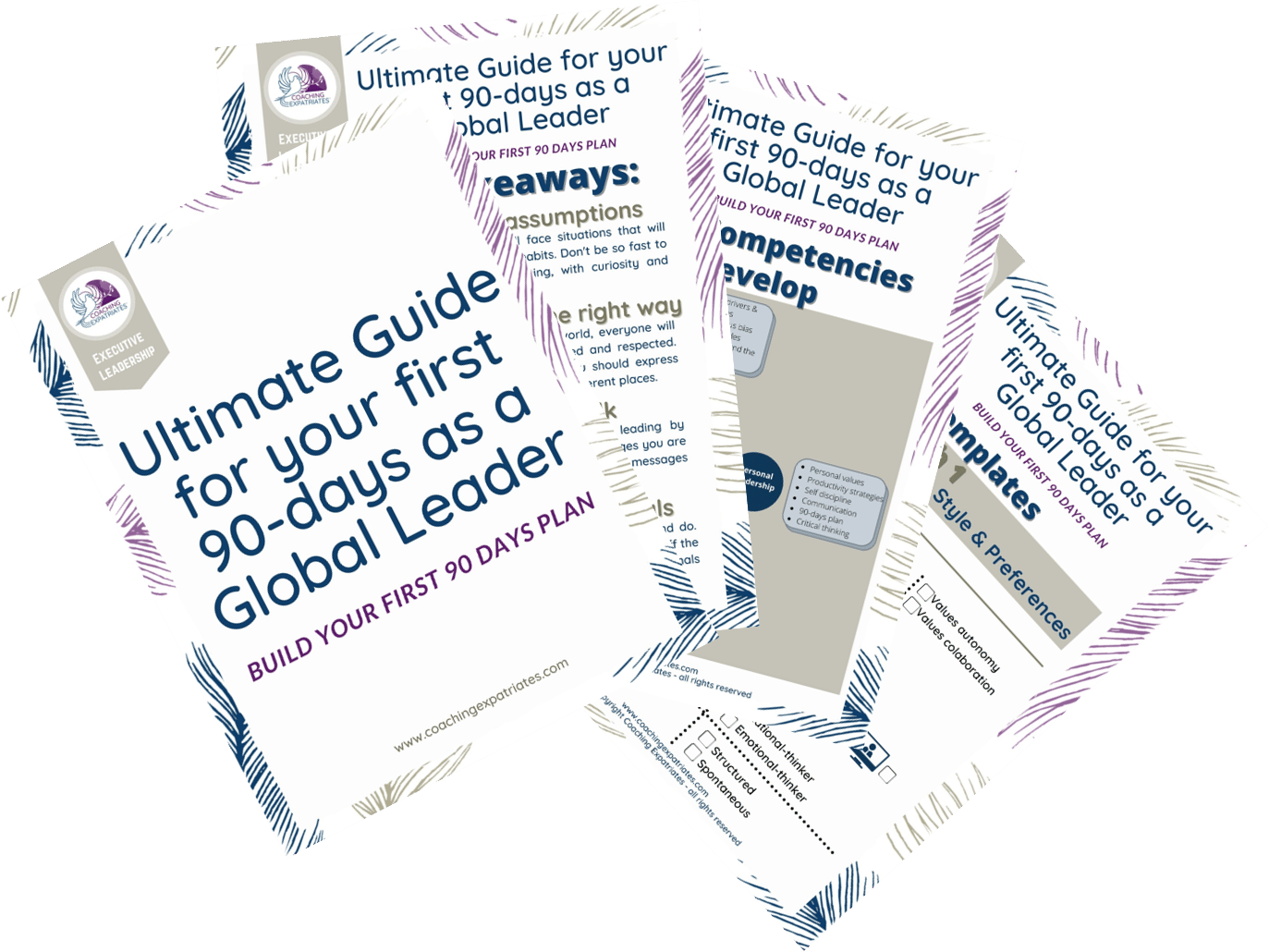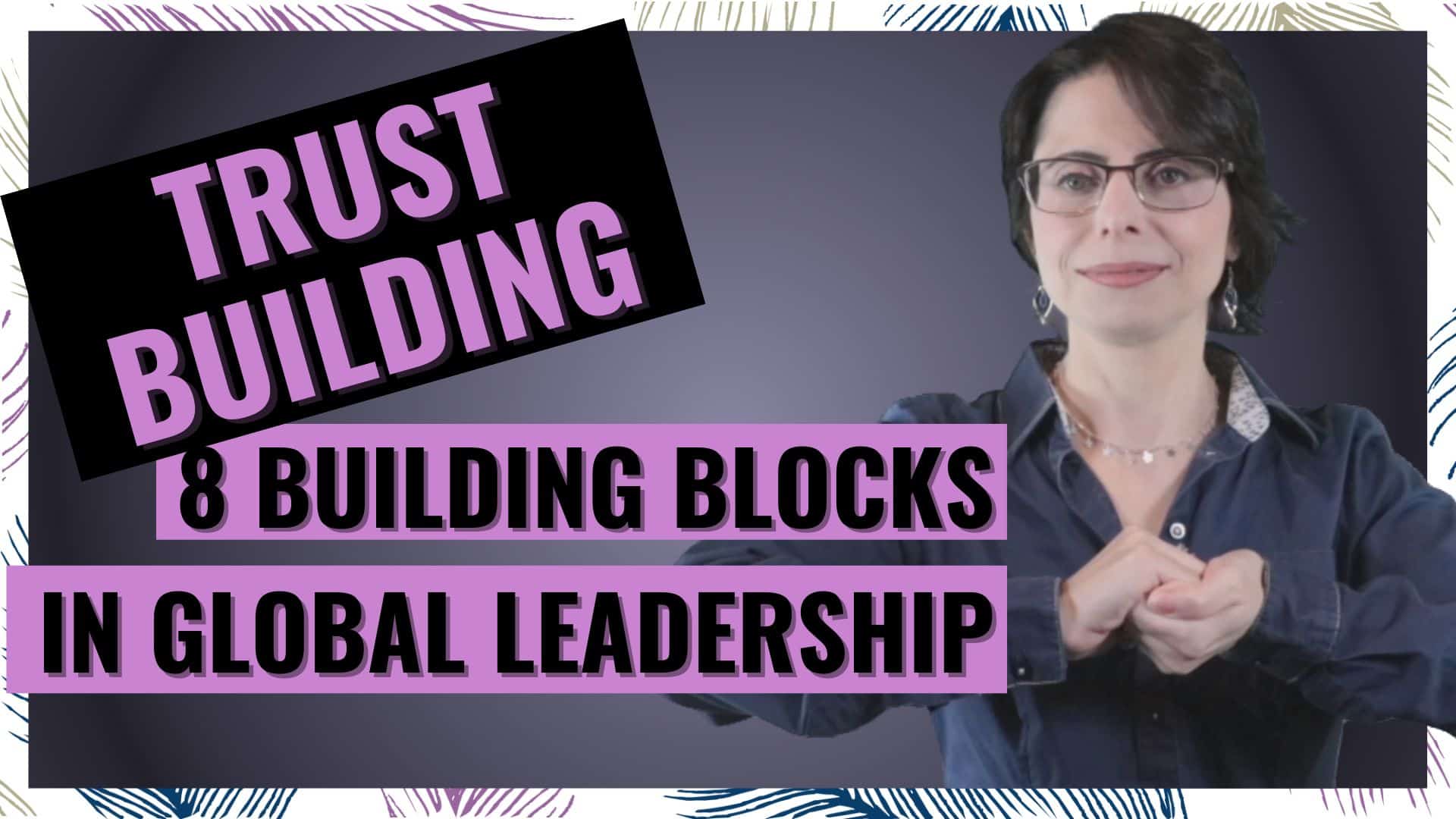
Trust building is a key component of global leadership. Because global leadership has many cross-cultural understanding challenges, the likelihood of misunderstandings is higher. Therefore, trust building in global leadership requires an extra effort and attention.
If you don’t know what this effort involves, you might not even know what to do in the first place. Or worse, you might do wrong things that will hurt trust building.
Today I will share with you the key elements to build trust in global workplaces, so that you can create collaborative teams and healthy working relationships.
Trust Building Blocks
We all know that we need trust in relationships of all kinds, and that trust takes time to build, and it can be ruined in a matter of seconds.
You need trust to build cohesive teams that collaborate and perform well together, to create good results and a positive working environment. If we don’t have trust, this creates suspicion, distrust, and bigger opportunities for misunderstandings.
Managers all over the world report that it can take them 5 times longer to complete a process when misunderstandings are involved. And even after they accomplish the goals, the time and energy wasted makes them feel exhausted and unfulfilled.
Building trust in global leadership to produce better and faster results takes an extra effort, because is has many uncertainties, ambiguity and cross-cultural challenges.
I want to share the key building blocks of trust so that you can be on the lookout for what needs to be done to build trust, with the relationships around you, even when working remotely in global settings.
Learn also others skills involved in People Leadership to create high performing collaborative teams.
1. Number Of Interactions
How many interactions you expect to have with a person can change the amount of effort they put into building trust.
We never know, though, for real, how many interactions we will have with a person. Every interaction with someone is an opportunity to build trust. The first interaction is often the most important one (and therefore the saying “you never get a second chance to make a first good impression”), because you can’t know for sure if you’ll have the chance again to interact and build further trust.
“You never get a second chance to make a first good impression.”
Proverb Tweet This!
The flipside is that, oftentimes, when people know there will be only one interaction, they might not really care if they hurt you, since there will be no consequence for their actions or future interaction to take responsibility.
For example, you might dismiss or even be rude to a vendor who is trying to pitch a new product to you, since you believe you’ll never talk to them again. But you might behave differently if this person works for a company you want to apply for a job. In this case, you expect repeated interactions, maybe with them or people they know. Your attempt at a greater first good impression will be higher.
Pro Tip
If you want to build trust with someone, start by trying to identify how many interactions you will have at your disposal to build trust and reputation. Include in your analysis the interactions with other people who have access to this individual as well. The more interaction opportunities you have, the easier it will be for building trust. However, also the greater risk at ruining it. Trust takes time to be built and each interaction counts. You will have to use all elements below in each interaction to build solid trust.
2. Honesty & Integrity
Well, we know that not everyone is honest and has the highest level of integrity. Every one of us encountered at some point in our lives a cheater, a liar, or worse. There are some studies that show that at least 5% of the global population is made of backstabbers: people who will stab you in the back just to prevent you from succeeding. They won’t gain anything with it. They just don’t want to see someone winning. So it is perfectly understandable that in every interaction, the people involved in it are skeptical about us. Are we in the 5%? Are we honest, or are we a backstabber? Signs of dishonesty and lack of integrity can hurt trust building, of course.
An example of this is when you put in your resume that you speak a language fluently, and when you are tested during the interview, you show clear signs not to be fluent. That hurts you more than expressing the lack of languege skill (or any other skill) in the resume. Consciously or unconsciously, people will think that if you are lying about something this simple, you might do even worse things when cornered.
Pro Tip
If you know you are lacking something that is needed, don’t lie about it. Instead, show what are you doing to improve it. State how you are improving it, and by when you want to accomplish a goal of improvement. This helps build trust not only because you are being honest, but because it sets an intention, builds reputation, and creates a sense of reliability and improving competence.
3. Reliability
Although sometimes people confuse lack of reliability with dishonesty, these are 2 different things. Reliability means you are reliable and you walk your talk. You keep your promises. People can count on you when you say so. When people see a lack of reliability in someone, trust building becomes challenging, because people don’t know what to expect of you. A key skill for reliability is managing expectations. If you manage it well, people will see you as more reliable. If you manage expectations poorly, they will see you as unreliable.
One example of this is consistency of behaviour. If you keep your promisses sometimes and break them others, this is an unconsistent behaviour. Unconsistent behaviours can give a perception of unreliability.
Pro Tip
It’s better to tell people you can NOT do something, then break your promise and be seen as unreliable. Manage people’s expectations by telling them upfront what they can expect from you or not. If you have trouble creating boundaries for people, hire an executive coach and work to develop this important skill.
4. Reputation
Reputation is what people know about you without first really knowing you. Reputation requires an important skill that very few people possess: impressions management. Although it’s true that first impressions are important, repeated interactions in business and/or communities will build a reputation over time.
Built reputation trumps first impressions. Period. In other words, if you build your reputation after your first impression, your reputation will matter more than the first impression. The message here must be clear: building a reputation is key to trust building and it’s a long-run game. Every interaction counts.
For example, you might be a shy person, and deliver your elevator pitch in an awkward way in your first interaction with your new team. Your introduction might give you off as stern and unarticulated. Maybe even aloof. But through hard work and time, you show your new team members to be a good leader, that can express ideas with articulation and confidence. In time, you grow a reputation of being able to lead ideas with conviction and good results even though they know you are shy.
Pro Tip
Define upfront what are the traits you want to be known for. Then, map what behaviors will help you express that trait to those around you. If you want to be known as a communicative person, arriving every day at the office without saying “hello” or “good morning” to your co-workers might not be a compatible behavior to build that kind of reputation.
5. Intention
Some people can “read you” well, others less so. But one thing is important to note: at some point, your intentions will become clear. Even if you try to do a good job at hiding them. This is what people often refer to as “showing their true colors.” If you enter an interaction saying that your intention is one, while actually intending something else, you are setting yourself up for failure in the long-run game of trust building.
For example, you might meet a potential client and invite them for a coffee with the secret intention of actually pitching a sales speech, in any first opening you have. Your prospect might feel hurt when they find out your real intention, as they might feel manipulated. A better way to approach will be to change the intention, to really get to know that person, and understand their real needs. If their needs meet your pitch, you can deliver it. Otherwise, you are just networking and will pass the pitch.
One intention that is key in trust building is the intention of being respectful. It goes without saying that being respectful is important, but in global leadership, due to cultural differences, how to express respect can be different depending on culture and context. If you have the right intention, though, people will eventually understand where you stand, even if you did not get to express it perfectly right according to that culture.
Pro Tip
In global leadership, win-win intentions will create better results in the long run, because even if a goal first fails, you will not fail the objective of building trust and a good line of communication. This means having the possibility to score goals in future interactions and opportunities. And this is only possible with a win-win intention since people will trust that you are not self-centered and egotistical when connecting or doing business.
6. Ability & Competence
You can be the nicest person in the world, the most honest person in the world, with the most impeccable reputation and intentions. Still, if you don’t have any ability and competence to provide or share value in an interaction, people will not trust you. More so, if you are expected to have a certain ability or competence and then do not show it. Of course, this will impact reputation, which will impact trust. As you can see, all these things are connected.
For example, let’s say you apply for an international job that needs an experienced manager, and once you are hired, you show lack of many people leadership traits & skills. So much so, that every team member’s performance deteriorates because of you. This will create trust roadblocks with those who made a bet on you during the hiring process.
Pro Tip
If you are willing to step out of your comfort zone and take on a challenge, make sure people around you know it, are on board with it, and can HELP you quickly close the gap, by assisting you in developing that competence. Also, consider priming yourself with all essential skills in the 4 success pillars of global leadership.
7. Authentic Connection
Similar to intentions, at some point, if your connection is not authentic and purposeful, you will be found out. You can’t hide fake emotions forever. What I mean about the authentic connection is regarding the emotional aspect and its intent.
Every connection has a purpose. “I am connecting with you to network.” will build less trust than “I am connecting with you because you work for a company that I admire and I want to learn more.” Again, managing expectations is a key skill when it comes to creating authentic connections.
The second important point about authentic connections is that who you are connecting with and hanging out with can automatically create or destroy trust. The proverb “Show me who your friends are, and I’ll tell you who you are” exists for that reason.
This is called affiliation. Affiliation means who you are hanging out with. If you are hanging out with troublemakers, you’ll be seen as a potential troublemaker. If you hang out with scholars, you will be seen as someone who likes to study or learn. Most people think about affiliation as something formal, like, “I’m affiliated with this political party.” When you think about trust, though, focus on the hidden messages you are sending through any type of affiliation, including the informal ones.
Pro Tip
Be real, be clear, and connect with purpose and honesty of intentions. When choosing affiliation and connections, make sure they resonate with your authentic self, ideals, and values.
8. Contextual Communication
How, why, and when we convey a message also play a significant role in trust building in a global leadership environment. Because this is such an important and complex topic, let’s discuss it in its own section below.
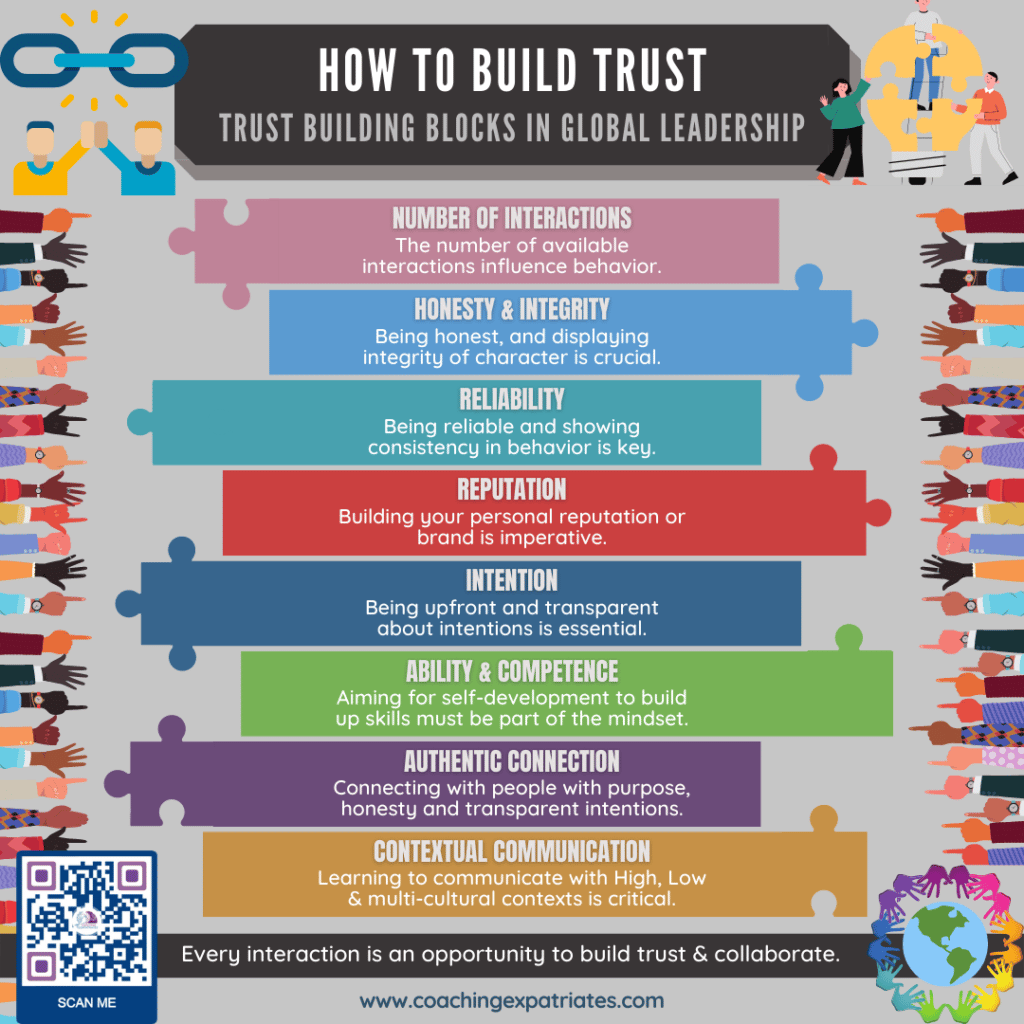
Multi-Cultural Communication In Trust Building
Although the trust building blocks mentioned above are pretty universal, how they are expressed can vary depending on cultural context. A culture can lean between high or low-context communication patterns.
High context cultures rely more on context and implicit cues during communication, while low context cultures rely less on them, making sure everything is explicit and in writing whenever possible.
This means you will have to observe the building blocks mentioned, in different ways, depending on the cultural context. Building trust in high context cultures will require a greater effort in understanding implicit meanings and second degee messages, while lower context cultures will require transparency of rules, messages and expectations as much as possible.
But what about trust building in multi-cultural teams?
If you are a seasoned global leader, you probably managed already all types of multi-cultural teams and learned your lessons the hard way. When dealing with multicultural teams, using the lowest context cultural patterns as baseline is more effective.
The main reasons for this are because understanding context in higher context cultures means you have shared its context before to understand it. Otherwise implicit messages will be misunderstood. In other words, if you didn’t live or immerse yourself in that culture to understand its cues and implicit messages, they will be received as if you came from a lower context culture. Even if you actually come from a high context culture.
If you are a Mexican, who has a higher context cultural pattern, engaging with a Chinese, who also has a higher cultural pattern, even though both are from high context cultures, you will still not understand clearly each other’s implicit messages or cues. And that’s because implicit messages and cues make sense within the same culture but not necessarily in others.
As a global leader managing multicultural teams, you should always create rules of engagement within your team based on a lower context pattern. This means you have to help you team reach the agreement about patterns that would be displayed in a lower context culture when managing and executing the workload.
For example:
- every meeting will be recapped at the end,
- tasks will be nominally assigned to individuals,
- objectives and respective tasks will be defined in writing,
- deadlines will be spelled out during meetings and then in writing,
- clarification questions will always be asked before wrap ups,
- expectations management will be performed even when the individual thinks they understood what’s expected
- “in-between the line messages” will not count as communication or be accepted
If multi-cultural teams reach an agreement to behave as low context cultures, and live up to this task, they can quickly move from storming to performing, and work profusely well. And with time, they will create their own cultural context.
The manager’s role in this effort will be extremely important: mentor higher context communicators to adjust to this new style, as they will always tend to behave with high context patterns.
Making it clear to all team members why this change is important becomes crucial:
- It creates trust within the team in a faster pace
- Processes become more reliable and teams more cohese
- Misunderstandings are more easily prevented
- Anxiety levels will lower, because everyone will know how they are expected to behave and what to do
The list can go on, but you get the gist of it. As a leader, you have to also realize something important. Bringing the team to a lower context pattern does NOT mean that higher context patterns are bad. Cultural context is not good or bad. Culture is culture. Bringing everyone to one same straightforward context is the same as bringing all your kids at different stages of growth to the pool that the youngest can stand up. You are making sure all your kids can go in a safe pool, where everyone there can stand and breathe safely while playing.
Your job as the global leader is to make sure you bring all your team members to a place of trust and cultural safety.
Final Thoughts On Trust Building
I hope I was able to clarify all the essential elements in trust building for you in a global leadership environment.
This is the moral of the story for you: every interaction counts in trust building. If you want to build trust with someone important, make sure you keep in mind that every interaction counts. Be honest, be reliable, make a great effort to build your reputation over time (not only with them, but with everyone around you), set the right intentions and communicate them clearly, and work on building up your abilities and skills. Make sure your connections are authentic. You’re not a psycho, so don’t behave like one.
Finally, if you are in an international context, realize that multi-cultural teams will need an extra effort to build trust and move from storming to performing. You will need to normalize and standardize expectations by creating a baseline. Creating rules of engagement for your team is the initial step to accomplish this. Having them create these rules, if you can, make them even more powerful and effective.
If you are interested in mapping out all the trust building blocks to your own situation and create a plan to close your gaps, consider hiring me as your executive coach and having a free strategy call. We will go over your situation and define the best course of action together.
If you are interested in developing trust building skills further, check out our online Global Executive Leadership Program. We go over all 4 success pillars of Global Leadership during 9 online modules, including 2 dedicated modules on People Leadership, where communication and trust building falls under.
If you enjoyed this post, consider subscribing to our newsletter using the form below. We focus on providing good content to global leaders and executives who want to make impactful business decisions and be more inclusive and influential. We know your inbox is sacred, so we email just once per week, and we never sell your information. Trust is the basis of Global Leadership, and we fully honor it.

